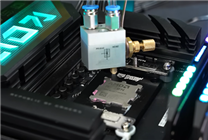Unlocking the Potential of Spray Cooling in Chip Heat Dissipation
Key Takeaways:
- Innovative Cooling Method: Spray cooling presents a cutting-edge alternative to traditional methods, particularly beneficial in supercomputing applications.
- Demonstrated Efficacy: Der8auer’s recent tests on a Ryzen 7 9800X3D CPU showcased the practical implementation of spray cooling, despite some limitations.
- Cooling Mechanics: The effectiveness of this technique relies on specific nozzle configurations and coolant properties.
In the evolving landscape of chip heat dissipation technologies, spray cooling is emerging as a formidable yet lesser-known method alongside conventional immersion and liquid nitrogen cooling. This innovative technique, primarily utilized in supercomputers, offers unique advantages that capture the attention of tech enthusiasts and professionals alike.
Recently, Der8auer, a renowned German overclocking enthusiast, released a video demonstrating the potential of spray cooling by applying it to a Ryzen 7 9800X3D CPU. This demonstration sheds light on how this advanced cooling method can challenge the status quo.
Understanding the Science Behind Spray Cooling
The operational principle of spray cooling is remarkably straightforward: it employs a nozzle positioned above the CPU or GPU, which sprays coolant directly onto the chip’s surface. Upon contact with the heat-generating component, the coolant evaporates, absorbing heat in the process. This evaporated coolant then cycles back to the cooling system, re-liquefies, and returns to the CPU, creating a continuous cooling loop.
Unlike conventional CPUs, the 2003 Cray X1 supercomputer processor, showcased by Der8auer, is specifically designed for spray cooling. It eliminates the traditional Integrated Heat Spreader (IHS) in favor of a stainless steel housing that incorporates essential components for effective spray cooling.
Key Factors for Effective Spray Cooling
In Der8auer’s setup, numerous tiny nozzles meticulously aim at the processor’s eight cores. Each nozzle’s orientation and the flow rate of the coolant are critical for ensuring comprehensive coverage. If any section of the chip is inadequately cooled, it risks overheating, which can impair performance.
Moreover, the choice of coolant is instrumental in achieving optimal results. The coolant must be non-conductive and possess a low boiling point to facilitate phase change at precise temperatures.
Performance Testing of Spray Cooling
To rigorously evaluate the effectiveness of spray cooling, Der8auer assembled a temporary system featuring the Ryzen 7 9800X3D CPU and a custom-modified water cooling setup. This dual-cycle system consists of one loop supplying coolant to an atomizer, while another circulates high-pressure air that mixes with the coolant, generating the desired spray.
While the initial results may seem underwhelming—Der8auer managed to achieve an impressive Cinebench R23 score of 18,164 at roughly 95 degrees Celsius—the spray cooling system’s success is hampered by inadequate coverage of the IHS. For reference, a traditional cooler typically enables the 9800X3D to achieve about 23,000 points.
Future Prospects for Spray Cooling
The test’s seemingly modest outcomes highlight a significant truth: the effectiveness of spray cooling is highly contingent on proper system configuration. While the atomizer only addressed a fraction of the IHS, fully optimizing the coverage area and adjusting the cooling system could yield vastly different results.
As microprocessors continue to advance and demand higher performance, innovative cooling techniques like spray cooling could become increasingly vital in managing heat dissipation. The burgeoning interest in this technology suggests that, with further development and refinement, spray cooling may soon compete with or even surpass traditional cooling solutions in specific applications.
Conclusion
Spray cooling represents a significant step forward in chip heat dissipation technologies. As demonstrated by Der8auer, while challenges remain in optimizing performance, its potential benefits warrant further exploration. As the tech community continues to investigate advanced cooling methods, spray cooling may emerge as a cornerstone for next-generation supercomputers and high-performance systems.
Investors, researchers, and tech enthusiasts should keep a close eye on this technology, as it may redefine expectations for thermal management in computing.






